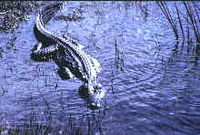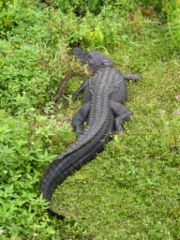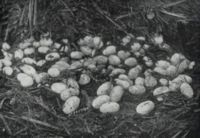| Alligators | ||||||||||||
|---|---|---|---|---|---|---|---|---|---|---|---|---|

An
American Alligator in captivity at the Columbus
Zoo
|
||||||||||||
| Scientific classification | ||||||||||||
|
||||||||||||
|
Alligator mississippiensis Alligator sinensis |
An alligator is a crocodilian in the genus Alligator of the family Alligatoridae. The name alligator is an anglicized form of the Spanish el lagarto ("the lizard"), the name by which early Spanish explorers and settlers in Florida called the alligator. There are two living alligator species: the American Alligator (Alligator mississippiensis) and the Chinese Alligator (Alligator sinensis).
Contents |
Description
Alligators are characterized by a broader snout and eyes more dorsally located than their crocodile cousins. Both living species also tend to be darker in color, often nearly black (although the Chinese alligator has some light patterning.) Also, in alligators only the upper teeth can be seen with the jaws closed (in contrast to true crocodiles, in which upper and lower teeth can be seen), though many individuals bear jaw deformities which complicate this means of identification.
The eyes of an alligator glow red when a light is shined on them. This fact can be used to find alligators in the dark.
According to the Everglades National Park website, the largest alligator ever recorded in Florida was 17 feet 5 inches long (5.3 meters). The largest alligator ever recorded measured 19 feet 2 inches (5.8 meters) and was found on Marsh Island, Louisiana.[1] Few of the giant specimens were weighed, but the larger ones could have exceeded a ton in weight.
Habitat

There are only two countries on earth that have alligators: the United States and China. The Chinese alligator is endangered and lives only in the Yangtze River valley. The American Alligator is found in the United States from the Carolinas to Florida and along the Gulf Coast. The majority of American Alligators inhabit Florida and Louisiana. In Florida alone there are an estimated more than 1 million alligators. The United States is the only nation on earth where both alligators and crocodiles live side by side. American Alligators live in freshwater environments, such as ponds, marshes, wetlands, rivers, and swamps. In China, they live only along the fresh water of the Yangtze River.
Behavior

Alligators are solitary, territorial animals. The largest of the species (both males and females), will defend prime territory; smaller alligators have a higher tolerance of other alligators within a similar size class.
Although alligators have heavy bodies and slow metabolisms, they are capable of short bursts of speed that can exceed 30 miles per hour. [2] Alligators' main prey are smaller animals that they can kill and eat with a single bite. Alligators may kill larger prey by grabbing it and dragging it in the water to drown. Alligators consume food that cannot be eaten in one bite by allowing it to rot or by biting and then spinning or convulsing wildly until bite size pieces are torn off. This is referred to as the "death roll."
Diet
Alligators are opportunistic feeders, eating almost anything they can catch. When they are young they eat fish, insects, snails, and crustaceans. As they grow they take progressively larger prey items, including: larger fish such as gar, turtles, various mammals, birds, and other reptiles. They will even consume carrion if they are sufficiently hungry. Adult alligators can take razorbacks and deer and are well known to kill and eat smaller alligators. In some cases, larger alligators have been known to hunt the Florida panther and bears, making it the apex predator throughout its distribution. As humans encroach onto to their habitat, attacks on humans are few but not unknown. Alligators, unlike the large crocodiles, do not immediately regard a human upon encounter as prey.
Unfortunately, human deaths caused by alligators have increased. While there were only 9 fatal attacks in the U.S.A. from the 1970s to the 1990s, 11 people were killed by alligators from 2001 to 2006. More deaths occurred in this 5-year period than did in the previous 30. For a long time people have been taught that alligators fear humans, which is true, but this has led some people to be foolhardy and enter the animal's habitat in ways that provoke aggression.
Reproduction

Alligators are seasonal breeders. The mating season is in spring when the water warms. The female builds a nest of vegetation that rots, incubating the eggs. The mother will defend the nest from predators and will assist the babies to water once they hatch. She will provide protection to the young for about a year if they remain in the area.
Farming
Alligator farming is a big and growing industry in Florida, Texas and Louisiana. These states produce a combined annual total of some 45,000 alligator hides. Alligator hides bring good prices and hides in the 6-7 foot range sell for $300 each. The market for alligator meat is growing and approximately 300,000 pounds of meat is produced annually.
References
- ^ Louisiana Fur and Alligator Advisory Council
- ^ Everglades National Park: Alligator Size, Weight & Speed




 216.73.216.190
216.73.216.190 User Stats:
User Stats:
 Today: 0
Today: 0 Yesterday: 0
Yesterday: 0 This Month: 0
This Month: 0 This Year: 0
This Year: 0 Total Users: 117
Total Users: 117 New Members:
New Members:
 216.73.xxx.xxx
216.73.xxx.xxx
 Server Time:
Server Time: